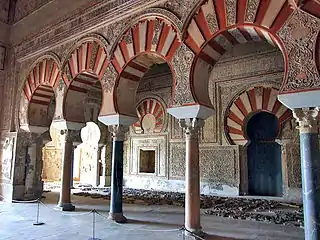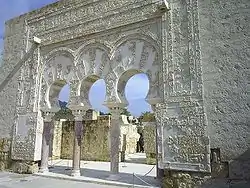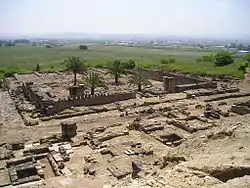Medina Azahara
Medina Azahara (Arabic: مدينة الزهراء, romanized: Madīnat az-Zahrā, lit. 'the shining city') is the ruins of a vast, fortified Andalus palace-city built by Abd-ar-Rahman III (912–961), the first Umayyad Caliph of Córdoba, and located on the western outskirts of Córdoba, Spain. It was the de facto capital of the Caliphate of Córdoba as the heart of the administration and government was within its walls.
| UNESCO World Heritage Site | |
|---|---|
 Reception hall of Abd ar-Rahman III | |
| Location | Córdoba, Andalusia |
| Criteria | Cultural: (iii), (iv) |
| Reference | 1560 |
| Inscription | 2018 (42nd session) |
| Coordinates | 37.888°N 4.867°W |
 Location of Medina Azahara in Spain | |

.jpg.webp)
Built beginning in 936–940, the city included ceremonial reception halls, mosques, administrative and government offices, gardens, a mint, workshops, barracks, residences and baths. Water was supplied through aqueducts.[1]
The main reason for its construction was politico-ideological: the dignity of the Caliph required the establishment of a new city, a symbol of his power, imitating other Eastern Caliphates. It was built in Córdoba because it had been the capital of the region (Betis) in Roman times; this made it easier for the Emirate and Caliphate of Cordoba to rule, while they existed, over al-Andalus. Above all, it demonstrated his superiority over his great rivals, the Fatimids of Ifriqiya in Northern Africa, as well as the Abbasids in Baghdad. Legend also says it was built as a tribute for the Caliph's favorite wife: Azahara.[2] The complex was extended during the reign of Abd ar-Rahman III's son Al-Hakam II (r. 961–976), but after his death soon ceased to be the main residence of the Caliphs. In 1010 it was sacked in a civil war, and thereafter abandoned, with many elements re-used elsewhere. Its ruins were excavated starting from the 1910s. Only about 10 percent of the 112 hectares (0.43 sq mi) have been excavated and restored, but this area includes the central area, with "two caliphal residences, with associated bath complexes, two aristocratic residences, and service quarters ... spaces associated with the palace guard; some large administrative buildings ... the extraordinary court complex presided over by the reception hall ... the great garden spaces, and just outside this area, the congregational mosque".[3]
Location
Located 4 miles (6.4 km) west of Córdoba in the foothills of the Sierra Morena, oriented north-to-south on the slopes of Jabal al-Arus (meaning Bride Hill), and facing the valley of the Guadalquivir river, is Madinat az-Zahra, billed as the Versailles of the Middle Ages. It was chosen for its outstanding landscape values, allowing a hierarchical construction program so the city and the plains beyond its feet were physically and visually dominated by the buildings of the fortress.
There was also a quarry of limestone, used for the primary construction, though other stones from an area 50 km around were also used.[4] The city's construction led to a road, water and supply infrastructure partly preserved until today in the form of remains of roads, quarries, aqueducts and bridges.
The topography played a decisive role in shaping the city. Taking full advantage of the uneven terrain, the palace city of Madinat az-Zahra was distributed in three terraces. Unlike the labyrinthine and chaotic character typical of Muslim urbanism, the site of the city adopted a rectangular shape comprising an area of 112 hectares. It extended 1,500 metres (4,900 ft) per side from east to west and about 750 metres (2,460 ft) from north to south, just warped on the north side by the need to adapt to the difficult topography of the terrain.
Its location in the foothills of Sierra Morena made it possible to design an urban program in which the location and physical relationships between the various constructions were expressive of the role of each in the setting. The palace was located at a higher level, and staggered its buildings along the side of the mountain in an expression of clear preeminence over the urban hamlets and the Aljama Mosque spread across the plains below. Following the terraces, the first corresponds to the residential area of the caliph, next comes the official area including the houses of the viziers, the guard-room, administrative offices and gardens. Next is the city proper, with housing, crafts, and the great mosque of the two lower terraces separated by another wall in order to isolate the upper palace complex. Archaeological research has revealed an urban morphology characterized by the existence of large areas of undeveloped land, which serves to empty the entire southern front of the fortress, ensuring privacy and maintaining an open, idyllic country landscape. The only spaces built on the lowest level are two broad bands: the western, with an urban management orthogon, and the eastern, with less rigid planning.
There were two complexes outside but close by the city, one a large villa at the centre of a large agricultural estate, later given to the state treasurer. The other, Turruñuelos, was a huge rectangular building, perhaps a barracks.[5]
Palace area
.jpg.webp)
The palace was built where the 1st century Roman aqueduct running from the Sierra Morena to Cordoba ran, but this was several metres below the palace, so a new spur was constructed further back to bring permanent running water to the higher levels. In turn, the section of the old Roman aqueduct now diverted was used as a main sewer for a highly complex system of small channels carrying away rain and waste water. Many food and ceramic remains have been found here.[6]
The initial construction of the palace was very rapid: begun in 936 or 940, the mosque was completed in 941 and by 945 the caliph was in residence, moving in the mint by 947. However, construction continued for decades, with many changes of plan and examples building-over previous buildings. The reception hall of Abd-ar-Rahman, or "Salon Rico", can be dated by inscriptions to between 953 and 957. The large "House of Ja'far" is built over three earlier houses,[7] and the building known as the "Court of the Pillars" replaced two earlier ones in the mid-950s.[8] The other large hall remaining, the so-called "upper basilical hall" or "Dar al-Jund" ("House of the Army", a name mentioned in literary sources) was also probably built in the 950s.[9]
In 2020, archaeologists discovered a gateway, that marked the eastern entrance to the 10th-century palace, which was missing for more than a thousand years.[10]
Gardens
There were at least three gardens in the city. A small garden, referred to as The Prince's Garden, was located on the upper terrace. This garden was for the use of the nobility, the wealthy, and the powerful; those who frequented the palace itself.[1]
The two lower terraces supported huge, formal Islamic gardens. The westernmost of these was the lowest terrace of the city. The easternmost of these two lower gardens, the middle terrace, led to the reception hall known as the Salon Rico. This eastern garden had a pavilion, surrounded by four rectangular pools, at its center. The four quadrants of this garden were sunken, and supplied with water from channels along the connecting walkways.[1]
History

.jpg.webp)
The city, which flourished for approximately 80 years, was built by caliph Abd-ar-Rahman III of Córdoba starting between 936 and 940. After he had proclaimed himself caliph in 928, he decided to show his subjects and the world his power by building a palace-city 5 km from Córdoba. The largest known city built from scratch in Western Europe, it would be described by travelers from northern Europe and from the East as a dazzling series of palaces full of treasures never seen before. Around 1010, Madinat az-Zahra was sacked by Berber rebels as part of a larger rebellion that led to the dissolution of the Caliphate of Cordoba.[11] The raid effectively wiped the city off the map for a millennium.
Popular legend holds that the Caliph named az-Zahra, or Azahara, after his favorite concubine, and that a statue of a woman stood over the entrance. Others, imagining his demanding lover, say that he built this new city just to please her. The truth, however, has probably more to do with politics than love. Abd ar-Rahman III ordered the construction of this city at a time when he had just finished consolidating his political power in the Iberian Peninsula and was entering into conflict with the Fatimid dynasty for the control of North Africa. Zahara means 'shining, radiant or blossoming' in Arabic: the name communicates aspirations of power and status, not romantic love.
Az-Zahra is the most common title for the daughter of Muhammad Fatimah az-Zahra. For that reason, the Fatimid dynasty of North Africa adorned many buildings and even towns with her name. Her title az-Zahra (the brilliant) was given to the al-Az'har/al-Azhar University in Cairo in 968, built by the Fatimids. The Umayyads' ambitions in North Africa could well explain the usage of the name for the new city to rival the Fatimids' influence there through Islamic/ religious iconography.
In 929, Abd ar-Rahman III declared himself utterly independent, the true Caliph (Prince of Believers) and descendant of the Umayyad dynasty, which had nearly been completely exterminated by the Abbasids in the 9th century. He brought about a series of political, economic and ideological measures to impress his legitimacy upon the world. A new capital city, befitting his status, was one of those measures. He decided to build the city in 936 and construction took about forty years. The Mosque on the site was consecrated in 941 and in 947 the government was transferred from Córdoba.[12]
In 2005, it was described by the American newspaper The New York Times as follows:
Teeming with treasures that dazzled the most jaded traveler or world—weary aristocrat...Pools of mercury could be shaken to spray beams of reflected sunlight across marble walls and ceilings of gold... Doors carved of ivory and ebony led to sprawling gardens full of exotic animals and sculptures made of amber and pearls..."[13]
What is visible of the ruins of Madinat az-Zahra today is only 10% of its extent. The 112 hectare-urb was no mere pleasure palace for weekend excursions, but the effective capital of al-Andalus, the territory controlled by the Muslims in the Iberian Peninsula from the beginning of the 8th century to the middle of the 11th. The magnificent white city, built in steps into the hillside at the base of the Sierra Morena with the Caliph's palace at the highest point, was designed to be seen by his subjects and foreign ambassadors for kilometers. Abd ar-Rahman III moved his entire court to Medina Azahara in 947-48. With time the entire city was buried, not to be unearthed until 1911.[14] Excavation and restoration continues, depending upon funding by the Spanish government. The unexcavated portion, however, is threatened by the illegal construction of housing. According to the New York Times, "The local government in Córdoba, he said, has failed to enforce a law passed 10 years ago that expanded protections for the site against development... Construction companies are putting up houses on the site of the city, 90 percent of which remains unexcavated." [13]
Artistically, the Medina Azahara played a great role in formulating a distinct Andalusian Islamic architecture. Many of its features, such as basilical royal reception halls (as contrasted with domed ones in the eastern part of the Islamic world) are here conceived for the first time. Other features, such as the arranging of the suites of rooms around a central courtyard or garden, are echoed throughout western Islamic architecture, for example as late as in the Alhambra. The Mosque of Medina Azahara bears close resemblance to the Great Mosque of Córdoba; it has been called its "little sister"[15]
Before coming to power, Al-Mansur Ibn Abi Aamir (also called Almanzor, from Spanish name) lived in the suburbs of Córdoba. On becoming the Hajib (Chamberlain to the Caliph) he decided to build a palace city for himself, which, if not more, was as beautiful as Medina Azahara built by Abd-ar-Rahman III.[16] Mansur called his palace with a very similar name: Madinat Az-Zahira ("the Shining City").[16][17][18] The location of the palace, which has never been excavated, is still debate: it may have been between Cordoba and Madinat az-Zahra to the west, or it may have been built to the east of Cordoba, in order to draw the focus of power away from the earlier Umayyad palaces.[19][16][18]
Mansur's purpose behind building this palace was to inspire awe and to have his name written in the pages of history along with the name of the greatest king of Al-Andalus, Abd-ar-Rahman III. It was a beautiful palace with extensive gardens around it. It housed the High officials and barracks for the guards of Al-Mansur.
However, on the death of Al-Mansur in 1002, his eldest son Abd al Malik Al-Muzafer succeeded to the throne, and on his death Abdar Rehaman As-Sanjul or Sanchelo or little Sancho (his mother Abda, was a daughter of Sancho the king of Pamplona), another son of Al-Mansur, followed his brother. People rose in revolt in Córdoba, while Sanchelo was busy in his expedition against Alfonso V in December 1009. Since Sanchelo was absent and there was nothing else in sight toward which to vent their anger, the people looted the palace built by Al-Mansur for four days. when they were through with the looting and plundering the palace, they put it to flames, and in no time the beautiful Az-Zahira was reduced to ashes.
Access and conservation

There are issues about the management of the site which is being affected by modern housing developments.
A museum on the edge of the site has been built low, with much of the space underground, to minimize disruption to the views of the landscape from the ruins.[20] The museum, which was designed by the firm Nieto Sobejano Arquitectos, won the Aga Khan Award for Architecture in 2010.
On July 1, 2018, the site was listed as a UNESCO World Heritage site with the inscription name "Caliphate City of Medina Azahara".[21]
Notes
- Ruggles, D. Fairchild (2008). Islamic Gardens and Landscapes. University of Pennsylvania Press. pp. 152–153. ISBN 978-0-8122-4025-2.
- Medina Azahara Guide
- Triano, 3
- Triano, 4-5
- Triano, 5
- Triano, 8-12
- Triano, 12-19
- Triano, 19-23
- Triano, 23
- "Lost gateway of fabled Medina Azahara unearthed in southern Spain". The Times. 13 March 2020.
- O'Callaghan, Joseph F., A History of Medieval Spain, Cornell University Press, 1975, Cornell Paperback 1983, p. 132
- Barrucand, Marianne & Bednorz, Achim, Moorish Architecture in Andalusia, Taschen, 2002, p. 61
- McLean, Renwick (2005-08-16). "Growth in Spain Threatens a Jewel of Medieval Islam". The New York Times. Retrieved 2010-05-12.
- D. F. Ruggles, “Historiography and the Rediscovery of Madinat al-Zahra',” Islamic Studies (Islamabad), 30 (1991): 129-40
- Barrucand, Marianne; Achim Bednorz (2002). Moorish Architecture in Andalusia. Taschen. p. 64.
- Bariani 2002.
- Kennedy, Hugh (1996). Muslim Spain and Portugal: A Political History of al-Andalus. Routledge. pp. 114, 125. ISBN 9781317870418.
- Arnold, Felix (2017). Islamic Palace Architecture in the Western Mediterranean: A History. Oxford University Press. pp. 115–117. ISBN 9780190624552.
- Ruggles, Fairchild (2000). Gardens, landscape, and vision in the palaces of Islamic Spain. Pennsylvania State University Press. pp. 111–113, 123–125. ISBN 0271018518.
- Museum and research centre by Nieto Sobejano Arquitectos.
- Centre, UNESCO World Heritage. "Caliphate City of Medina Azahara". whc.unesco.org. Retrieved 2018-07-01.
References
- Barrucand, Marianne; Achim Bednorz (2002). Moorish Architecture in Andalusia. Taschen.
- D. Fairchild Ruggles, Gardens, Landscape, and Vision in the Palaces of Islamic Spain, Philadelphia: Pennsylvania State University Press, 2000
- D. F. Ruggles, “Historiography and the Rediscovery of Madinat al-Zahra',” Islamic Studies (Islamabad), 30 (1991): 129-40
- Triano, Antonio Vallejo, "Madinat Al-Zahra; Transformation of a Caliphal City", in Revisiting al-Andalus: perspectives on the material culture of Islamic Iberia and beyond, Editors: Glaire D. Anderson, Mariam Rosser-Owen, BRILL, 2007, ISBN 90-04-16227-5, ISBN 978-90-04-16227-3, google books
- Bariani, Laura (2002). Al Madina al-Zahira segun el testimonio de las fuentes arabo-andalusies. II Congreso Internacional la Ciudad en Al-Andalus y el Magreb (in Spanish). Fundación El legado andalusì. p. 332. ISBN 9788493205171..
External links
| Wikimedia Commons has media related to Medina Azahara. |
- Medina Azahara, the whim of the first Caliph of Al-Andalus
- Madinat al-Zahra by art historians (English)
- Madinat al-Zahra by art historians (Spanish)
- The Shining City: Qatar Visitor
- Columbia "briefing" by Prof. Dodds
- Medina Azahara in Córdoba, Spain in Spanish
- Al-Andalus: the art of Islamic Spain, an exhibition catalog from The Metropolitan Museum of Art (fully available online as PDF), which contains material on Medina Azahara (see index)
- The Art of medieval Spain, A.D. 500-1200, an exhibition catalog from The Metropolitan Museum of Art Libraries (fully available online as PDF), which contains material on Medina Azahara (see index)
- Medina Azahara, in VirTimePlace.
